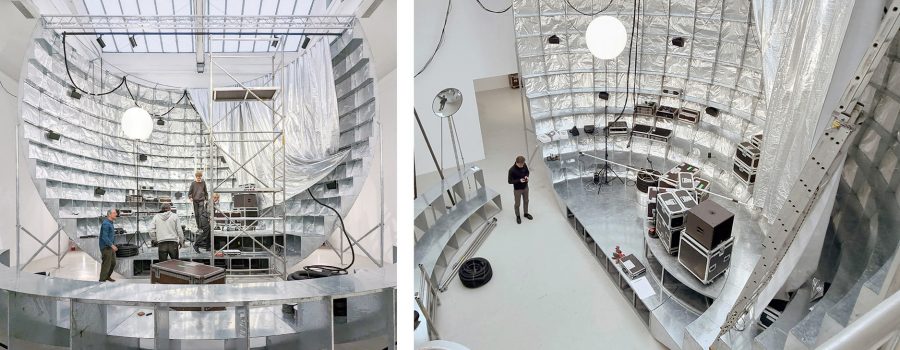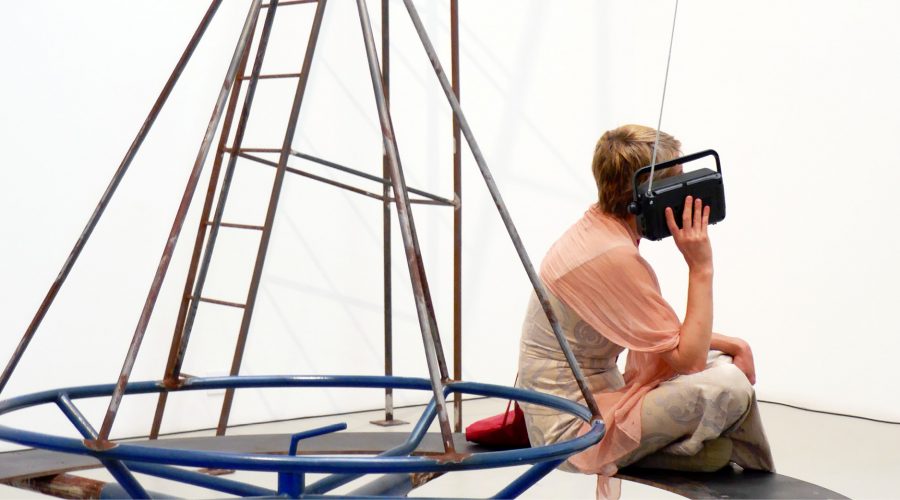
Ball Theater: Sound, fiction, occupation
The following text, co-written by the art historian Carlotta Darò and the architect Nicolas Tixier, is the foreword of the special issue of L'Architecture d'Aujourd'hui, which documents the various events and interventions on the theme of Sound scheduled in the French Pavilion at the Venice Architecture Biennale 2023, and particularly the Radio Utopia project.
The Voyager 1 space probe, which was sent into space by NASA in 1977, carried a golden record known as The Sounds of Earth. This record aimed to convey a condensed interpretation of human history on Earth to potential extraterrestrial civilisations through a collection of nature sounds, music, and speeches. A sense of impending apocalypse accompanies the words of President Jimmy Carter, engraved on the record: “We are attempting to survive our time so that we may live into yours.” At a time of growing eco-anxiety, the golden record is still wandering in interstellar space. A science-fictional object from the past, it propels us into a future that we are still envisioning.
Radio Utopia occupied the Ball Theater for five days in August 2023, as part of the French Pavilion’s vision of architecture as a receptacle for life. Designed as a sound laboratory and radio antenna, Radio Utopia provided a platform for receiving and broadcasting discussions, testimonies, sounds, music, and installations. Choosing radio made it possible to question the socio-cultural conditions of an event such as the Architecture Biennale, from a restricted circle of visitors to Venice in August. Radio broadcasting serves as both a parable and a tangible means of connecting with distant places and potential differences using sound recording. It also offers the possibility of extending an event beyond its physical location and ephemeral temporality. Radio Utopia has left an audio trace in a corner of the World Wide Web, for an indeterminate length of time.
This special issue of L’Architecture d’Aujourd’hui looks back on the material generated throughout the week, situating it within the broader Ball Theater project, including its actors and authors. The content has been transformed and adapted for the magazine. Between the format of the article, the carte blanche, the oral comment and the transcribed interview, the contributions to the issue continue the moments of interaction, the radio programmes and the artistic proposals that took place on and off site.
This issue opens with the theme of a party. Thinking of the festival as a cycle, an era, a story that progresses through various periods (see the interview between OFFICE Kersten Geers David Van Severen and studio Muoto), the subject engages the social and political role inherent in architecture. On the one hand, the innate need to live and celebrate collectively, on the other the call to question the social order that this celebration requires. Music, dance, and loud expressions of joy are essential for a party. Parties are also about sound. Several authors have looked at sound as an object of research, as an aesthetic and architectural exploration, as a medium of communication or quite simply as an expression of life.
Sound also embodies the idea of occupation, of an atmospheric agent that fills an architectural container at a given time. It comes and goes without a trace. The nature of sound is part of the desire to liberate the imagination put forward by the pavilion’s architects. The exploration of visionary projects in the tradition of utopian and dystopian narratives, and fiction as a source of inspiration for architects, is at the heart of other contributions and reflections in this issue.
Finally, the materiality of the project and architecture serves as the backdrop for these remarks. While touching on a variety of disciplinary approaches from the authors and guest contributors, this special issue keeps the project and the object of the pavilion, its architectural proposal, at the centre of its development and iconography. The hybrid nature of the pavilion allows for various readings and contributions, as it encompasses architecture, scenography, and structure. Its theoretical references encompass the autonomy of architecture, through the evocation of the sphere to the pop icon of the faceted bubble, its nudity and frugality allow us to question the tension between speculative project and constructed reality.
Please visit our e-shop to discover the AA special issue dedicated to the Ball Theater in the French Pavilion at the 18th Venice International Architecture Biennale.



